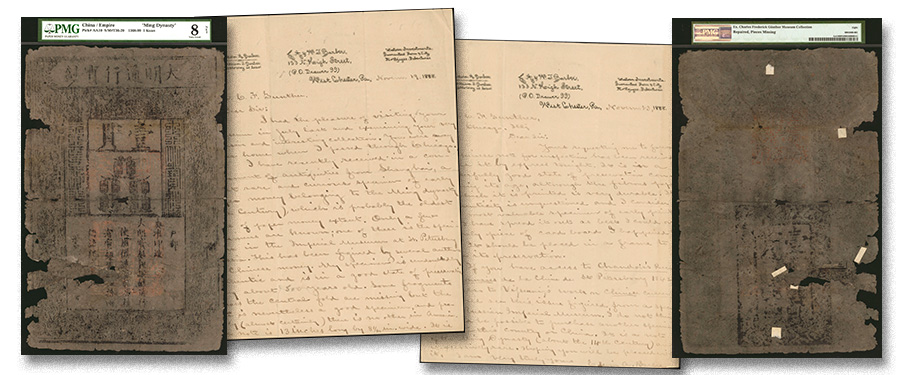
In our 10 Year Anniversary Sale at the Mira Hotel in Hong
Kong, we will be once again be offering a few Ming Dynasty notes in various
conditions. However, one note will stand out from the group, but not for the
typical reasons like vermillion overprints or bold impressions.
While the note may be extensively
circulated with minor paper repairs and visible paper loss, it accompanied by a
story that propels its desirability well beyond the typical example. Understanding
why however, requires insight of the modern history of this note. These notes
were once great rarities, but two modern finds have supplied interested
collectors with the opportunity to own what would otherwise seem destined for a
museum. the first was a bundle found in 1900 by forces intervening in the Boxer
Rebellion; the second find occured in 1936 as one of the walls that surrounded
Beijing was being torn down, The note we offer in our upcoming Hong Kong
auction, however is one of the few notes known that predate those finds, and is
likely the only example outside of a museum with the accompanying documentation
to prove it!
Dated November 19, 1888, the first letter accompanying this
note reads:
Mr. C. F. Gunther,
Dear Sir:
I had the pleasure of visiting your museum in July last and
examining your very extensive and interesting collection. You were away from
home when I passed through Chicago.
I have recently received in a consignment of antiques from
Shanghai, a most rare and curious specimen of early paper money belonging to
the Ming dynasty (14th Century), which is probably the oldest issue of paper
money extant. Only a few specimens are known; one of these is the specimen in
the Imperial Museum at St. Petersburg Russia. This has been figured by several
authors on Chinese money. My specimen is undoubtedly authentic and is in a good
state of preservation being about 500 years old. Some fragments across the
central fold are missing but the note is nevertheless a good specimen, and probably
(almost certainly) there is no other in America. The note is 13 inches long by
8-1/2 in. wide. It is interesting as being probably the oldest paper money
known and as showing the printing of the Chinese probably 500 years ago. This
specimen considering its great rarity should be worth $50. As I am not
speculating, however, I will let you have it for $20. I sent to China four
years ago to a collector for one of these notes. He has only just found one.
Since writing him I have sold my collection of paper money and therefore give
you the first chance to secure the specimen at a low figure. I shall be glad to
send it to you for inspection.
Yours very truly,
Edwin A. Barber
A few days later, on November 23, 1888, a second
correspondence from Mr. Barber reads:
Mr. C. F. Gunther,
Chicago, ILL.,
Dear Sir:
Yours requesting me to forward the Chinese note for
inspection has been received. I send it by express tonight. It is in a
wonderfully good state of preservation considering its age, although the
fibrous paper on which it was printed is very durable. Its authenticity is
unquestioned and I consider it a most valuable specimen of early printing. I
have spread it out as best I could on the only piece of card board I happened
to have. It should be placed in a frame to insure its preservation.
If you have access to Chaudoir’s Recueil de Monnaies de la
Chine de St. Petersbourg 1842, and also to Vifsennig’s (sp?) work on Chinese
Currency you will see this issue figured from a specimen in the Russian
Imperial Museum. I do not think it would be possible to purchase another
specimen either in this country or China. It is a note of the Ming Dynasty
(about the 14th Century) and is excessively rare. Hoping you will be pleased
with it. I am very truly yours
Edwin A. Barber.
Mr. Gunther, made wealthy by his success in the candy
business, obviously couldn’t turn down the opportunity to add this intriguing
historical artifact to his museum. This museum, among other things, came to
hold such American relics as Abraham Lincoln’s deathbed and the table that
Robert E. Lee used to sign the Confederate surrender documents at the
Appomattox Court House. After Gunther’s passing in 1920, the Chicago Historical
Society would buy his collection in whole for $150,000. It later became the foundation
for what is today known as the Chicago History Museum.
The Stack’s Bowers Hong Kong auction will be held in
conjunction with the Hong Kong Coin Show, March 23-25, 2020, at the Mira Hong
Kong Hotel. For more information, visit StacksBowers.com.





